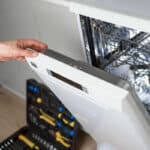Unless you wash your clothes by hand, chances are you use your washing machine pretty regularly. But what happens when it starts to not work properly? Do you call a Colorado Springs washing machine repair service right away, or do you troubleshoot the problem yourself to see if it’s an easy fix? First, it’s important to note that if your washing machine is under warranty, you will probably need a certified washing machine repair technician to do the work. If you do the work yourself, you’ll risk voiding the warranty and you’ll be financially on the hook for any further repairs. TThese three issues are a few of the most common washing machine problems and how to troubleshoot them yourself before calling in a pro. You can find more detailed information specific to your washing machine in the owner’s manual.
1. Your Washing Machine Is Making Strange Noises
If you’re hearing a funny noise, take note of when you hear them during the washing machine’s cycle. For example, a noise that is noticeable during or after the spin cycle is indicative of a problem with the drain pump. This pump drains the water from the tub during and after the spin cycle. A noisy drain pump indicates that something is either restricting it (a clog in the drain) or the pump itself is faulty.
Front-loaded washing machines have shock absorbers that are used to diminish the tub movement inside the machine. If these shock absorbers are damaged or become worn out, you’ll hear loud banging sounds during the spin cycle. If this is the case, the shock absorbers will need to be replaced. Neglecting the shock absorbers on your washing machine can cause damage to other components.
2. Washing Machine Leaks
Are you noticing water around your washing machine after doing a load of laundry? If so, then you have a leak. Leaks are a fairly straightforward problem to troubleshoot.
The two main culprits of washing machine leaks are the drain and fill hoses. The drain hose is what drains the water out of the machine before the spin cycle, and the fill hose is what brings water into the tub before the wash cycle.
The fill hoses are usually located on the rear of the machine and connect to your house’s water supply. Inspect the hose carefully, making sure that all connections are tight and secure. Also carefully inspect the hose itself to see if it is cracked or has a hole.
You’ll also find the drain hoses on the back of the washing machine. Perform the same inspection you did on the fill hose. However, you’ll also need to inspect your house’s drain that the drain hose connects to. If there’s a clog in the house drain, then water can back up into the drain hose.
3. Your Washing Machine Will Not Start
When it comes to the most common washing machine problems, nothing is more aggravating than getting a load of laundry ready, and the washing machine just sits there silently, refusing to do any work.
Troubleshooting this problem depends on the type of washing machine you have. If it’s a front-loaded machine, then there are two big reasons why the machine won’t start: the door switch isn’t closed and/or the door lock isn’t activated. These are both safety features of most modern washing machines. If either one of those components is malfunctioning, the machine will not start. For safety reasons, this is by design.
Because modern washing machines are more digital than ever, it’s almost always a good idea to call a certified repair technician if your machine isn’t starting. There is delicate circuitry in the machine that most people aren’t qualified to repair. The last thing you want to do is void the warranty or make the problem worse.
Ask For Help
Some of the most common washing machine problems listed above are more complex than others. Consider hiring a professional appliance repair person to help you fix the problem. And like everything else, washing machines don’t last forever. Most have a lifespan of about 10-15 years. If your washing machine is getting up there in years, then it probably makes more sense to replace than to keep repairing. A licensed technician can help you make this decision.




